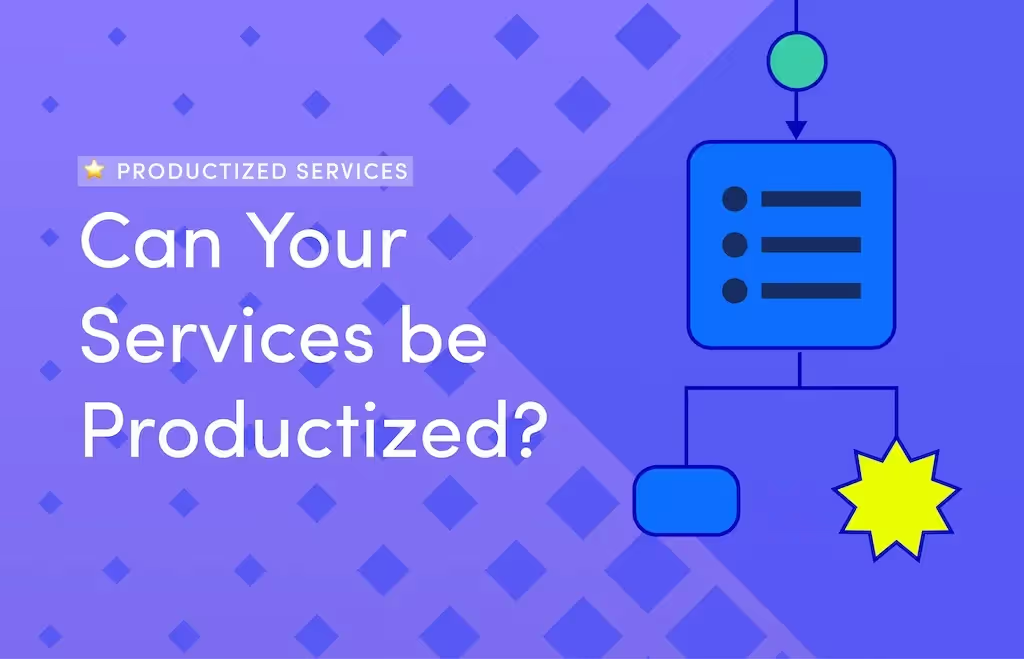Can Your Services be Productized? Figure it Out with This Checklist
Wondering if you can make the switch to productization, too? We’ve got a checklist to help you figure that out.




Wondering if you can make the switch to productization, too? We’ve got a checklist to help you figure that out. Just read through the questions below. If you can answer yes to all of them, your service business is a great candidate for productization.
Ready? Let’s get started!
The first question you need to ask yourself is whether it’s possible to define a distinct audience for your services.
In traditional one-to-one service-based models, freelancers and agencies often cast a broad net when it comes to finding customers. They send out individual proposals and craft unique solutions for clients so as to not rule out potential customers with different needs.
When you productize, you move away from this high-effort selling method and instead focus on one well-defined target customer. This is an easier switch for some businesses than others.
The easiest way to define your audience is to think of your dream client. What kind of customers have you worked with in the past who you’d love to work with over and over again?
Now that you’ve identified your target audience, the next step is to put together a standardized offering that solves a specific problem for that audience.
This time, think about the kind of work you do best and enjoy the most. Can you boil that down to a specific end-solution?
For example, let’s imagine you’re running an SEO agency. You’ve been tailoring your services to include a little of everything, depending on what the client needs: backlink building, guest posting, SEO audits, rewrites, site speed optimization, etc.
But you enjoy handling guest posts for clients in the home decor niche most. This is because you have plenty of connections in that space so you know it’ll be quick and easy to land those guest posts, which also means your profits will be higher.
Bingo—you have your standardized offering. You can sell guest post packages for home decor sites.
Next, you need to validate your new productized offer concept, and the first step is to make sure it’s viable for your target audience. Is the product you’ve created something your client wants?
There’s an easy way to do an initial check for this: ask your clients for feedback. Find a few of those ‘dream clients’ that you’ve worked with and approach them with a question like ‘here’s my idea. Would there be any interest in this?’
Another part of the validation process is to make sure there’s sufficient demand for your productized offer.
You’re going to be targeting a much narrower market now that you’ve better defined your audience. Is that market still wide enough that you can make enough sales?
For example, let’s say you’re a content writer. Before productization, you were sending out proposals to pretty much anyone that needed written content. Now that you’ve productized, you’ve decided to focus on one specific niche: blog posts for pet websites.
Are there enough pet websites out there that might need blog content? And can you still effectively market your productized services to those customers?
One of the main reasons to productize is that you create something scalable.
The question is: can you scale up your team alongside demand? If you start selling more units than you’re used to, do you have the resources needed to fulfill those orders? Can you find those resources easily if you don’t have them now?
Productizing means using fixed rates rather than custom quotes. Can you still make a profit with that pricing model?
For example, let’s imagine again that you’re a content agency. You’ve decided to create a standardized offer and sell 2,000-word blog posts for $500 each.
You priced this up based on the average amount of time it takes your writers to write these articles (4 hours). You plan to pay your writers $50 per hour, so you could be making a $300 profit per unit sold.
The problem is that in reality, the time investment can vary dramatically from project to project. Some 2,000-word posts on highly-complex topics can take as much as 7 hours to research and write, whereas others will take you just 2-3 hours. If it’s the former, you won’t make a profit after paying your writers.
Plus, you will need to take into account all the effort and tools required to fulfill the service outside of the production time.
Another key benefit of productization is that it allows you to leverage automation and systematize parts of your offer so you can earn more money with less effort. Think about how this might look in practice for your business. What parts of the process can you automate?
Before we wrap up, let’s bring everything we’ve talked about together. Use this checklist to determine if your services can be productized.
𝥷- Can you define a distinct audience for your service?𝥷Can you create a standardized offering?𝥷Is your productized offer viable for your target customer?𝥷Is there sufficient demand for it?𝥷Do you have the resources to fulfill your standardized service?𝥷Can you sell it at a fixed and profitable rate?𝥷Can you automate or systematize parts of the process?
Did you check all the boxes? If so, why not start setting up your productized service business today with the help of ManyRequests? You can sign up for a free trial here.